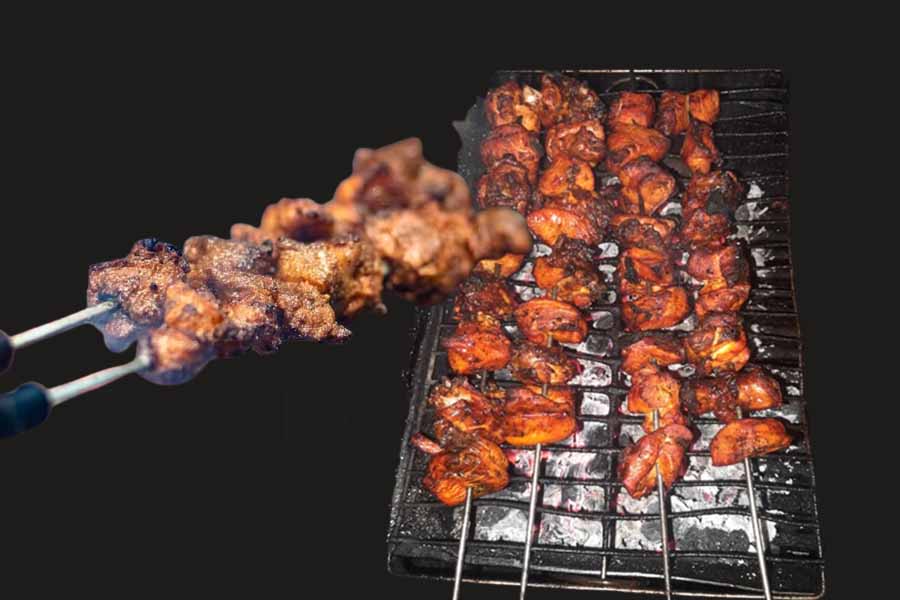What is the most popular food in Nepal?
The Impact of Fast Food Culture and Online Food Ordering on Health and the Need for Regulation
Kathmandu — Ordering food online has become a new trend for us. But among us, many wonder what others are ordering or how our tastes have changed. Among the favorite dishes of most Nepalis, momo and chowmein have become the subject of numerous jokes and memes. After spending an hour looking at the menu in a restaurant, it’s often said as a joke that Nepalis end up ordering momo and chowmein.

The statistics of various companies providing online food delivery services also show a high demand for momo and chowmein. However, recently, items like biryani, fried chicken, pizza, burgers, samosas, and other snacks have also seen a significant increase in orders. We have observed the food delivery business booming not only in Kathmandu Valley but also in other cities and have compiled a list of the most ordered items in the breakfast area, based on the orders placed in the top five companies operating in this field. The companies have provided a long list of the food they have delivered in the past few months, along with details of the top 10 most ordered items. From that list, we have mentioned the top 10 favorite items among Kathmandu residents.
When it comes to the details of the received food, when Kathmandu residents order the most, biryani takes the first place, followed by momo. Then, in order, we see burgers, pizza, fried chicken, rolls, samosas, naan, chowmein, and noodles. Among these, there is a significant demand for various chicken dishes among the Kathmandu residents. Chicken biryani, chicken momo, chicken burgers, and fried chicken are among the most ordered items on various online food apps. Buff momo also remains highly popular. In vegetarian meals, samosas have seen increased demand, and some people even order Gulab Jamun for dessert. The list of items ordered through online platforms includes Newari delicacies, chicken chili, chicken fried rice, dosa, chicken nuggets, and cakes.
According to the latest internal study conducted by a new service provider, approximately 8 out of 10 food delivery orders in Kathmandu are received through the app and website of various food delivery service providers. Among them, Pathao Foods, Foodmandu, Bhoj Deals, Food Gunj, Khanepani, and Bhok Lagyo have been receiving the highest number of orders through their respective apps. Pathao claims to receive around 6,000 orders per day. Food delivery service providers have expanded their services not only in Kathmandu but also in other urban areas. The scope of the delivery service in Nepal is increasing, as expressed by the number of people involved in this field.
Fast food companies receive more than 70% of orders at Foodgunj, which averages around 150 deliveries per day. According to Birsal Gurung, the current CEO of the company, “Orders are mostly placed by the age group of 18 to 30 years. Fast food offers convenience and enjoyable eating experiences, which is why we receive more orders in this category.” According to Gurung, the most ordered items at Foodgunj include biryani, momo, chowmein, pizza, rolls, burgers, noodles, dosa, and more. He mentioned, “Biryani had fewer orders before, but now its popularity has increased. It’s one of the items that receives a lot of demand here.”
According to the information provided by Manohar Adhikari, who has been involved in the online food delivery sector for the past 12 years, there has been a significant increase in the demand for fried chicken, burgers, biryani, and pizza, despite the previous lack of enthusiasm for such options. He says, “Previously, there were limited options for food in restaurants, but now there are various apps, websites, and other digital platforms available for easy ordering and payment, which has led to an increase in the trend of ordering and delivery.”
Journalist Ranjit Tamang had recently made a satirical tweet about Momos and Chowmein, referring to them as the gateway to heaven for Nepalis. He humorously mentioned that even if one goes to the countryside or the city, Momos and Chowmein are everywhere, and even donkeys don’t eat maize anymore.
In terms of recording songs in the studio, they prefer to eat items like chicken, rap, rolls, etc. He says, “It becomes sluggish when ordering food from outside restaurants. Sometimes when the whole family goes out, they order food online, eat it on the way home, and even share it with others. This has made life easier.”
In the past decade or so, among the various changes in the lifestyle of Nepalis, there has also been a significant change in the style of food consumption. In the past decade, the trend of having a hearty meal with local dishes like beaten rice, bhutteko makai-bhatmas, churra, murai, sātu, chana, and roti had declined. Now, these dishes have made a comeback in various forms. In urban areas like Kathmandu, along with momos and chowmein, the consumption of pizza, burgers, biryani, and fried chicken has become widespread. Traditional food has been replaced by burger houses and chicken stations, while the old-style tea stalls have been transformed into cafes and coffee shops.
In the past decade and especially after the COVID-19 pandemic, one aspect that has become prominent in Kathmandu is the trend of ordering food for delivery, even while staying at home. This change in the lifestyle of urban dwellers has led to an increase in the number and income of businesses such as food delivery platforms, mobile apps, etc. Popular online food delivery companies include Foodmandu, Pathao Food, Bhojdeal, Foodganj, Khanpin, Tato Mitho, BhojaMandu, Bhojan Nepal, Mills and Wheels, Gharko Khaja, Fooddoo, Falcha Food, etc. Along with these, restaurants and hotels have also started offering delivery services for their dishes, charging a delivery fee.
Especially, Pathao, well-known for ride-sharing services, is now offering special offers and promotions for food delivery, which indicates that it is expanding its food delivery business alongside ride-sharing. This suggests the expanding market for food delivery businesses in the Kathmandu Valley. Sagar Gurung, the Food Operations Manager at Pathao Food, says, “On average, we receive about 6,000 orders every day. On Wednesdays, when there is a 45% discount on the menu, we deliver an average of 600 dishes.” According to him, the current economic situation has resulted in a slightly lower number of orders. Pathao Food has around 550 delivery staff, while more than 700 restaurants have joined them. The most ordered dishes include chicken steam momo, chicken biryani, chicken burger, fried chicken, etc.
In the past six years, there has been a high demand for KFC products in Nepal, according to manager Santosh Khadka. He mentioned that along with Korean, Chinese, and Japanese cuisines, sets like Thakali are also becoming increasingly popular. He said, “We receive a lot of orders for items like momo, pizza, burgers, rolls, biryani, KFC-style fried chicken, samosa, sandwiches, cakes, and tandoori items, among others. Apart from operating more than a thousand restaurants, the company has expanded its services to various cities outside Kathmandu, keeping in mind the growing business.”
Arjun Tamata, the operator of Nepal Restaurant and an online food delivery company, stated that they deliver biryani to every household in Kathmandu. He said, “Here, apart from chow mein, the demand for Hyderabadi dum biryani, sekuwa, choila, pizza, and fried rice is also high. Out of a total of 140 items on the menu, 60% of the orders consist of biryani, pizza, fried rice, burgers, and sekuwa.” They receive orders from 4 am to 1 am, and Tamata mentioned that they often get overwhelmed during nighttime. He jokingly said, “Having had enough of rice and lentils during the day, people can order biryani for a change. Once they taste our biryani, they become addicted to its flavor, and they keep ordering it every week.”
Experts in this field attribute the growing trend of online ordering to factors such as a busy lifestyle, convenience, higher income levels, and fashion. This medium has also become convenient for those who don’t want to cook at home. Singer Pramod Kharel points out that due to a busy lifestyle, installing food apps on mobile phones has become common, and he himself uses online platforms to satisfy hunger cravings.
Santosh Dhakal, a 47-year-old resident of Bhaktapur, orders food from Pathao Food, Foodmandu, and similar apps to fulfill the culinary preferences of his children. He says, “I personally prefer home-cooked food, but my sons and daughters crave burgers, pizza, and KFC-style items. Ordering such food every 15 days or once a month satisfies their taste buds. Despite the flavors and fashion of home-cooked meals, young boys and girls are inclined towards exotic foreign cuisine.” The two sons of Babu Dhakal also mention that even though outside food may sometimes compromise the quality of language; it is easy to cook when they feel like preparing it.
Ankit Jha, who works in an IT company in Australia, shares his experience of easily and economically ordering food instead of cooking after work. He says, “I work for about 12-13 hours, so I don’t have time to cook. After placing an order, food arrives at my doorstep according to my preference. I usually order sausages, choila, and meal sets. The delivery services are quick, which makes it convenient.” He expresses that it is more cost-effective to order food rather than struggling to cook at home.
According to nutritionist Praneeti Singh from Narbhik Hospital, there is a prevailing fast food culture that is affecting people’s health. She shares her experience of observing a decrease in the consumption of home-cooked meals due to the increasing trend of ordering food online. She says, “People used to cook meals like dal-bhat (lentils and rice) but now they prefer to visit restaurants that serve dal-bhat as the crowd and chaos of restaurants make it challenging. The trend of ordering food online is also growing. As a result, we are witnessing an increase in the number of patients with obesity, high cholesterol, and hypertension.”
10 Best Sekuwa Restaurants in Kathmandu
Singh explains that high blood pressure issues, which used to be observed after the age of 50, are now seen in individuals aged 30-33. Similarly, cholesterol problems are occurring at the age of 25. She states, “All these problems are related to our eating habits. Adult diseases are now prevalent in young individuals. Avoiding outside food completely is not possible, but we can try to consume it once a week or once a month. In other times, we can opt for yogurt with flattened rice, roasted soybeans, fruits, vegetables, and chickpeas.”
Despite the increasing business and options in the food industry, questions arise regarding the measurement and regulation of its quality. Although occasional actions have been taken by the Department of Commerce Supplies and Consumer Protection to investigate and take action against stores, the overall improvement in the quality of fast food and imported ingredients remains a matter of concern.
Gajendra Kumar Thakur, Director-General of the department, says, “There is no specific law to regulate e-commerce businesses like online food deliveries. We are currently working on seeking information from service providers and restaurants based on complaints and inquiries. However, due to the lack of appropriate legislation, the regulation process is challenging.”
“Kantipur Daily Exclusive: Sajana Baral Unveils the Most Ordered Foods in Nepal“
 Uncanny Content TheKDBlog No 1 Technology Blog helps you live a dream life with blogging. TheKDblog help to tech lover provide Tech News, Bike, Movie, share, Blogging, etc
Uncanny Content TheKDBlog No 1 Technology Blog helps you live a dream life with blogging. TheKDblog help to tech lover provide Tech News, Bike, Movie, share, Blogging, etc


